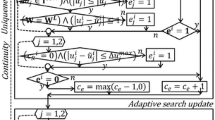Abstract
In this present study, the moisture-induced deformation behaviour of a spruce sample was analysed one- and two-dimensionally with high resolution on the radial-tangential surface. For this purpose, an artificial speckle pattern was applied to the surface which was then recorded by a CCD camera during the deformation. The generated TIF images were analysed with a strain mapping software (VIC 2D) that computed the two-dimensional strain field from the surface deformation.
Selected options to evaluate two-dimensional data generated with X-ray imaging and digital image correlation are presented. Combining and correlating these techniques enables detailed analysis of structure-function relationships during swelling (and shrinkage) processes in wood. However, several issues still have to be solved to enhance effectiveness and user-friendliness of such investigations, as elucidated in detail in this paper.
Zusammenfassung
In dieser Arbeit wurde das feuchte-induzierte Deformationsverhalten einer Fichtenholzprobe ein- und zweidimensional mit hoher Auflösung auf der radial-tangentialen Probenoberfläche analysiert. Dazu wurde ein künstliches Specklemuster auf die Probenoberfläche aufgebracht, welches dann mit einer CCD-Kamera während der Deformation gefilmt wurde. Die generierten TIF-Dateien wurden mit einer Bildkorrelationssoftware (VIC 2D) ausgewertet, welche die zweidimensionalen Dehnungen auf der Probenoberfläche berechnete.
Es werden ausgewählte Möglichkeiten zur Auswertung zweidimensionaler Daten vorgestellt, die durch Röntgendurchstrahlung und digitale Bildkorrelation generiert wurden. Einerseits ermöglicht die Kombination und Korrelation dieser Techniken eine detaillierte Analyse von Struktur- Eigenschafts-Beziehungen während der Quell- (und Schwind-) Prozesse in Holz. Andererseits müssen noch einige Probleme gelöst werden, um die Effektivität und die Benutzerfreundlichkeit derartiger Untersuchungsmethoden zu verbessern, was in diesem Artikel im Detail beleuchtet wird.



Similar content being viewed by others
References
Bucur V (ed) (2011) Delamination in wood, wood products and wood-based composites. Springer, Dordrecht
Garab J, Keunecke D, Hering S, Szalai J, Niemz P (2010) Measurement of standard and off-axis elastic moduli and Poisson’s ratios of spruce and yew wood in the transverse plane. Wood Sci Technol 44(3):451–464
Havimo M, Rikala J, Sirvio J, Sipi M (2008) Distributions of tracheid cross-sectional dimensions in different parts of Norway spruce stems. Silva Fenn 42(1):89–99
Haller P, Wehsener J (2004) Mechanical properties of densified spruce. Holz Roh- Werkst 62(6):452–454
Hild F, Roux S (2006) Digital image correlation: from displacement measurement to identification of elastic properties—a review. Strain 42(2):69–80
Keunecke D, Hering S, Niemz P (2008) Three-dimensional elastic behaviour of common yew and Norway spruce. Wood Sci Technol 42(8):633–647
Keunecke D, Niemz P (2008) Axial stiffness and selected structural properties of yew and spruce microtensile specimens. Wood Res 53(1):1–14
Keunecke D, Mannes D, Niemz P, Lehmann E, Evans R (2010) Silviscan vs. neutron imaging to generate radial softwood density profiles. Wood Res 55(3):49–60
Mannes D (2009) Non-destructive testing of wood by means of neutron imaging in comparison with similar methods. Dissertation, ETH Zurich
Niemz P (1993) Physik des Holzes und der Holzwerkstoffe. DRW, Leinfelden-Echterdingen
Pan B, Qian KM, Xie HM, Asundi A (2009) Two-dimensional digital image correlation for in-plane displacement and strain measurement: a review. Meas Sci Technol 20(6)
Perré P, Huber F (2007) Measurement of free shrinkage at the tissue level using an optical microscope with an immersion objective: results obtained for Douglas fir (Pseudotsugamenziesii) and spruce (Picea abies). Ann Sci For 64(3):255–265
Reiterer A, Lichtenegger H, Tschegg S, Fratzl P (1999) Experimental evidence for a mechanical function of the cellulose microfibril angle in wood cell walls. Philos Mag A 79(9):2173–2184
Valla A, Konnerth J, Keunecke D, Niemz P, Müller U, Gindl-Altmutter W (2011) Comparison of two optical methods for contactless, full field and highly sensitive in plane deformation measurements using the example of plywood. Wood Sci Technol, doi:10.1007/s00226-010-0394-7
Wagenführ R (2007) Holzatlas. Fachbuchverlag im Carl Hanser Verlag, Leipzig
Author information
Authors and Affiliations
Corresponding author
Rights and permissions
About this article
Cite this article
Keunecke, D., Novosseletz, K., Lanvermann, C. et al. Combination of X-ray and digital image correlation for the analysis of moisture-induced strain in wood: opportunities and challenges. Eur. J. Wood Prod. 70, 407–413 (2012). https://doi.org/10.1007/s00107-011-0573-8
Received:
Published:
Issue Date:
DOI: https://doi.org/10.1007/s00107-011-0573-8




